Introduction
Your deck is one of the most enjoyable parts of your home—perfect for relaxing, entertaining, and outdoor living. But over time, exposure to the elements leaves it looking dirty, stained, and weathered.
The solution? Power washing. A thorough cleaning can restore your deck’s natural beauty, remove built-up grime, and extend its lifespan. However, not all decks are the same, and improper pressure washing can cause damage, splinter wood, or even void warranties on composite decking.
At H2O Mobile Pressure Washing, we know the right techniques to safely clean both wood and composite decks, leaving them spotless without causing harm. In this guide, we’ll walk you through the do’s and don’ts of power washing your deck to keep it looking its best.

Why Power Washing is Essential for Deck Maintenance
Your deck is constantly exposed to sun, rain, dirt, and organic growth, which can lead to:
✔️ Mold and mildew buildup, making the surface slippery and unsafe
✔️ Gray, faded wood, caused by sun and weather exposure
✔️ Stains from dirt, leaves, and spills, diminishing its appearance
✔️ Algae and moss growth, which can weaken the structure over time
Without proper cleaning, these issues can lead to expensive repairs or even require a full deck replacement. Power washing helps:
- Extend the life of your deck by removing damaging contaminants
- Improve safety by eliminating slippery mold and algae
- Restore color and beauty to make your outdoor space inviting again
However, incorrect power washing techniques can do more harm than good. Let’s break down the right way to clean wood and composite decks.
The Do’s and Don’ts of Power Washing a Wood Deck
✅ Do: Use the Right Pressure Setting
Wood is softer than concrete or brick, meaning too much pressure can cause irreversible damage. We recommend:
- 500-1200 PSI for softwoods (pine, cedar)
- 1200-1500 PSI for hardwoods (teak, mahogany)
Using the correct pressure ensures a thorough clean without gouging the wood.
✅ Do: Use a Wide-Angle Spray Tip
A 25-degree or 40-degree nozzle spreads out the pressure, preventing damage while still effectively removing dirt. Never use a 0-degree nozzle, as it can cut into the wood and leave visible marks.
✅ Do: Work in the Direction of the Wood Grain
Always spray along the length of the boards, not across them. This prevents uneven streaking and damage to the fibers.
✅ Do: Let the Wood Dry Completely Before Sealing or Staining
After power washing, wood absorbs moisture. Let it dry for at least 24-48 hours before applying stain or sealant to ensure proper adhesion and protection.
❌ Don’t: Use Too Much Pressure
Blasting wood with high pressure (above 1500 PSI) can:
- Splinter the surface, making it rough and unsafe
- Strip away protective sealants, leading to faster deterioration
- Cause permanent grooves, ruining the deck’s appearance
❌ Don’t: Ignore Mold or Mildew Stains
If you see black or green patches, your deck likely has mold or mildew. Power washing alone won’t kill the spores. A specialized cleaning solution is needed to remove them completely and prevent regrowth.
❌ Don’t: Power Wash a Deck in Direct Sunlight
Washing in hot, sunny conditions can cause water to dry too quickly, leaving streaks and uneven cleaning marks. It’s best to wash in cooler, shaded conditions for even results.
The Do’s and Don’ts of Power Washing a Composite Deck
Composite decking is a blend of wood fibers and plastic, making it more durable and resistant to rot than natural wood. However, it still requires proper cleaning to maintain its appearance.
✅ Do: Use Low Pressure (500-800 PSI)
Unlike wood, composite materials can be damaged by excessive pressure. Using a low-pressure setting prevents scratching and surface damage.
✅ Do: Use a Gentle Cleaning Solution
Mold, mildew, and dirt embed into the textured surface of composite decking. A mild, biodegradable detergent helps lift grime without harming the material.
✅ Do: Rinse Thoroughly to Avoid Soap Residue
Leftover cleaning solution can leave a filmy, sticky residue that attracts more dirt. Always rinse the deck thoroughly after washing.
❌ Don’t: Use a Wire Brush or Harsh Scrubbing Tools
Composite decking has a protective coating that can be damaged by abrasive materials. Stick to soft-bristle brushes or microfiber cloths for stubborn spots.
❌ Don’t: Let Mold Sit Too Long
Although composite decking is resistant to rot, it’s still susceptible to mildew and algae growth, especially in shady areas. Regular power washing prevents stains from becoming permanent.
When Should You Power Wash Your Deck?
The best times to power wash your deck are:
✔️ Spring – Remove winter grime and prepare for outdoor gatherings
✔️ Late Summer – Clean up pollen, BBQ grease, and summer foot traffic
✔️ Fall – Wash away leaves and debris before winter weather hits
For decks with high moisture exposure, twice-a-year cleanings help prevent mold and algae buildup.
Why Hire a Professional for Deck Power Washing?
While some homeowners attempt DIY power washing, many accidentally cause damage due to:
❌ Too much pressure, splintering wood or damaging composite decking
❌ Uneven cleaning, leaving streaks or missed spots
❌ Using the wrong detergent, leading to discoloration or residue buildup
At H2O Mobile Pressure Washing, we ensure:
✅ Safe pressure settings customized for wood and composite decks
✅ Biodegradable, eco-friendly cleaning solutions
✅ Even, streak-free results with no damage
✅ Expert removal of mold, mildew, and stains
Hiring a professional means better results, no risk of damage, and a faster, hassle-free cleaning process.
Restore Your Deck’s Beauty—Schedule a Power Wash Today!
Don’t let dirt, mildew, and stains ruin your outdoor space. A professional power wash can restore your deck’s appearance and extend its lifespan.
📞 Call us today at 216-369-1000 for a FREE quote
🌎 Visit our website: www.h2ompw.com
Let H2O Mobile Pressure Washing help you protect and revitalize your deck with expert cleaning services!
